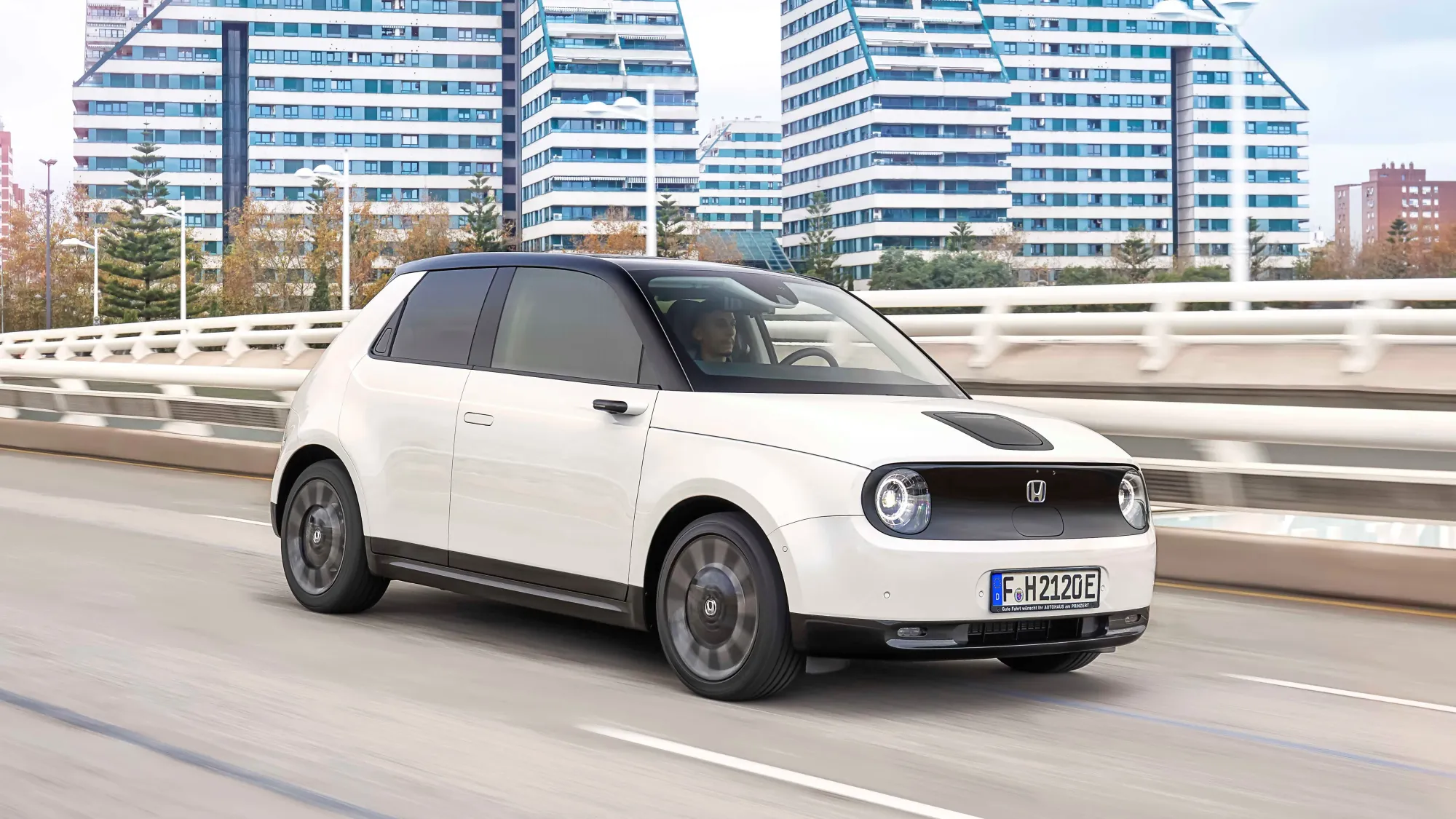When exploring the world of electric vehicles, the Honda e and Mazda MX-30 EV stand out for their unique approaches to design, technology, and performance. This comparison will delve into the key differences and similarities between these two models, providing insights that are particularly valuable for electric vehicle enthusiasts, tech-savvy readers, and prospective buyers.
Pricing and Trim Levels: Honda e vs Mazda MX-30 EV
Pricing and trim levels are crucial as they directly influence the overall value and features available in an EV.
-
💰 Base Model Pricing: The Honda e starts around $38,000, offering a tech-focused interior with a 136-mile range. The Mazda MX-30 EV begins at approximately $34,000, providing a more traditional yet stylish design with a 124-mile range.
-
🚀 Performance Trims: Honda e offers a more powerful Advance variant, focusing on tech enhancements. Mazda MX-30 has limited performance trims, maintaining a single electric motor setup focused on efficiency rather than speed.
Design and Exterior Features: Honda e vs Mazda MX-30 EV
Design and exterior features significantly impact an EV's appeal by combining aesthetics and functionality.
-
🎨 Aerodynamic Design: Honda e's retro-futuristic design enhances aerodynamic efficiency, contributing to its agility. Mazda MX-30, with its coupe-like silhouette, focuses on style but slightly compromises aerodynamic efficiency.
-
💡 Lighting and Aesthetics: The Honda e features circular LED headlights that provide a distinctive, modern appearance. Mazda MX-30's sleek LED lights offer a more conventional but elegant look.
-
🚪 Unique Features: The Honda e showcases a panoramic glass roof and pop-out door handles. In contrast, the Mazda MX-30's freestyle doors provide a unique touch, offering easier access to the rear seats.
-
📏 Exterior Dimensions: Honda e's compact dimensions make it highly maneuverable in urban settings. Mazda MX-30 is slightly larger, accommodating more interior space but making it less nimble.
Interior and Cabin Space: Honda e vs Mazda MX-30 EV
Interior comfort and space are vital for a pleasant driving experience, especially in electric vehicles.
-
🪑 Seating and Comfort: Honda e offers a cozy, minimalist cabin with plush seats. The Mazda MX-30 provides a more spacious interior with sustainable materials, emphasizing comfort and eco-friendliness.
-
📱 Technology Integration: Honda e's dashboard features a multi-screen setup with seamless infotainment connectivity. Mazda MX-30 includes a simpler interface with a focus on ease of use.
-
🧳 Storage and Utility: Honda e's compact design limits trunk space, while Mazda MX-30 offers more cargo capacity, catering to those needing additional storage.
Performance and Acceleration: Honda e vs Mazda MX-30 EV
Performance and acceleration are critical for those seeking an engaging driving experience.
-
⚡ Acceleration and Speed: Honda e accelerates from 0-60 mph in about 8.3 seconds, offering peppy urban performance. Mazda MX-30 is slower, taking roughly 9.7 seconds, focusing more on comfort than speed.
-
🛞 Handling and Drive Modes: Honda e delivers responsive handling with sportier dynamics. Mazda MX-30 provides smooth handling with a focus on comfort and stability.
Range and Battery Options: Honda e vs Mazda MX-30 EV
Range and battery options determine the practicality and usability of an EV.
-
🔋 Battery Options: Honda e is equipped with a 35.5 kWh battery, suitable for city driving. Mazda MX-30 also features a 35.5 kWh battery, aligning with its urban-oriented design.
-
🌍 Real-World Range: The Honda e offers about 136 miles, ideal for city commutes. Mazda MX-30's range of 124 miles requires frequent charging for longer trips.
Technology and Safety Features: Honda e vs Mazda MX-30 EV
Technology and safety features enhance the overall driving experience by ensuring comfort and security.
-
🤖 Driver Assistance Features: Honda e includes features like adaptive cruise control and lane-keeping assist. Mazda MX-30 offers similar technologies, focusing on driver engagement.
-
🚘 Full Self-Driving (FSD): Both models lack full self-driving capabilities, concentrating on advanced driver assistance instead.
-
🛡️ Active Safety Features: Both vehicles are equipped with collision avoidance and emergency braking systems, ensuring passenger safety.
-
⭐ Crash Test Ratings: Honda e boasts high safety ratings from Euro NCAP. Mazda MX-30 also scores well, emphasizing strong safety credentials.
Charging Options and Infrastructure: Honda e vs Mazda MX-30 EV
Charging options and infrastructure are crucial for the convenience and feasibility of owning an EV.
-
⚡ Home Charging: Both models support standard Level 2 home charging, suitable for overnight charging.
-
🌍 Public Charging Networks: Mazda MX-30 leverages widespread charging networks. Honda e requires reliance on public stations, with less extensive options compared to Tesla's Supercharger network.
Charging Speed: Honda e vs Mazda MX-30 EV
Charging speed influences the practicality of recharging an electric vehicle.
-
⚡ Home Charging Speed: Honda e charges in about 4 hours with a 7.4 kW charger. Mazda MX-30 has a similar home charging speed.
-
🌍 Fast Charging Speed: Honda e supports rapid charging, reaching 80% in 30 minutes. Mazda MX-30 offers comparable fast-charging capabilities.
-
🛠️ Third-Party Chargers: Both models are compatible with third-party charging networks, offering flexibility in charging locations.
Customization Options: Honda e vs Mazda MX-30 EV
Customization options allow buyers to create a vehicle that reflects their personal style and preferences.
-
🎨 Exterior Colors: Honda e offers vibrant color choices, appealing to those seeking a distinctive look. Mazda MX-30 provides a range of subdued, elegant hues.
-
🛞 Wheel Designs: Honda e offers futuristic wheel designs, enhancing its unique aesthetic. Mazda MX-30 opts for classic wheel styles that complement its overall design.
-
🪑 Interior Trims: Honda e features modern interiors with eco-friendly materials. Mazda MX-30 emphasizes sustainability with its cork and recycled fabric elements.
Conclusion: Honda e vs Mazda MX-30 EV
Summarizing the comparison, each model has its strengths and considerations.
-
✅ Strengths of Each Model: Honda e excels in urban maneuverability and high-tech interiors. Mazda MX-30 offers a more spacious cabin and a distinctive door design.
-
❌ Considerations: Honda e's limited range might pose challenges for longer trips. Mazda MX-30's slower acceleration may not appeal to those seeking a sporty drive.




